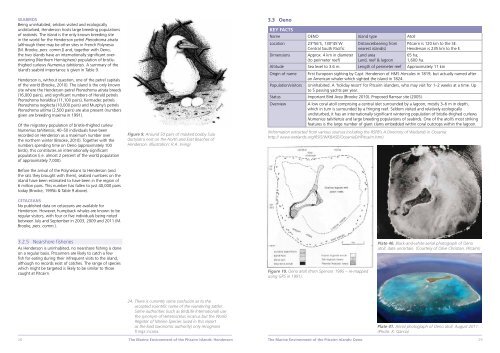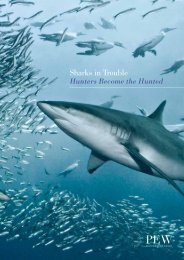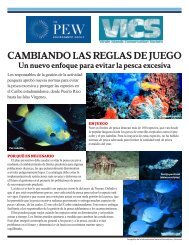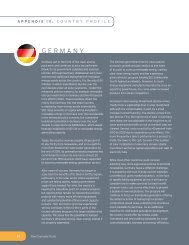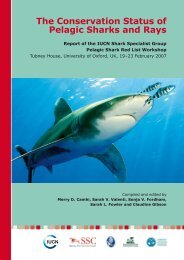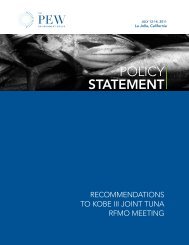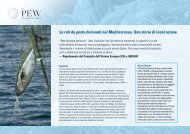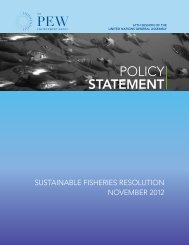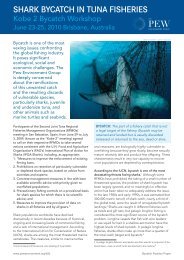The Marine Environment of the Pitcairn Islands - Pew Environment ...
The Marine Environment of the Pitcairn Islands - Pew Environment ...
The Marine Environment of the Pitcairn Islands - Pew Environment ...
You also want an ePaper? Increase the reach of your titles
YUMPU automatically turns print PDFs into web optimized ePapers that Google loves.
SEABIRDS<br />
Being uninhabited, seldom visited and ecologically<br />
undisturbed, Henderson hosts large breeding populations<br />
<strong>of</strong> seabirds. <strong>The</strong> island is <strong>the</strong> only known breeding site<br />
in <strong>the</strong> world for <strong>the</strong> Henderson petrel Pterodroma atrata<br />
(although <strong>the</strong>re may be o<strong>the</strong>r sites in French Polynesia<br />
[M. Brooke, pers. comm.]) and, toge<strong>the</strong>r with Oeno,<br />
<strong>the</strong> two islands have an internationally significant overwintering<br />
(Nor<strong>the</strong>rn Hemisphere) population <strong>of</strong> bristlethighed<br />
curlews Numenius tahitiensis. A summary <strong>of</strong> <strong>the</strong><br />
island’s seabird importance is given in Table 9.<br />
Henderson is, without question, one <strong>of</strong> <strong>the</strong> petrel capitals<br />
<strong>of</strong> <strong>the</strong> world (Brooke, 2010). <strong>The</strong> island is <strong>the</strong> only known<br />
site where <strong>the</strong> Henderson petrel Pterodroma atrata breeds<br />
(16,000 pairs), and significant numbers <strong>of</strong> Herald petrels<br />
Pterodroma heraldica (11,100 pairs), Kermadec petrels<br />
Pterodroma neglecta (10,000 pairs) and Murphy’s petrels<br />
Pterodroma ultima (2,500 pairs) are also present (numbers<br />
given are breeding maxima in 1991).<br />
Of <strong>the</strong> migratory population <strong>of</strong> bristle-thighed curlew<br />
Numenius tahitiensis, 40–50 individuals have been<br />
recorded on Henderson as a maximum number over<br />
<strong>the</strong> nor<strong>the</strong>rn winter (Brooke, 2010). Toge<strong>the</strong>r with <strong>the</strong><br />
numbers spending time on Oeno (approximately 100<br />
birds), this constitutes an internationally significant<br />
population (i.e. almost 2 percent <strong>of</strong> <strong>the</strong> world population<br />
<strong>of</strong> approximately 7,000).<br />
Before <strong>the</strong> arrival <strong>of</strong> <strong>the</strong> Polynesians to Henderson (and<br />
<strong>the</strong> rats <strong>the</strong>y brought with <strong>the</strong>m), seabird numbers on <strong>the</strong><br />
island have been estimated to have been in <strong>the</strong> region <strong>of</strong><br />
6 million pairs. This number has fallen to just 40,000 pairs<br />
today (Brooke, 1995b & Table 9 above).<br />
CETACEANS<br />
No published data on cetaceans are available for<br />
Henderson. However, humpback whales are known to be<br />
regular visitors, with four or five individuals being noted<br />
between July and September in 2003, 2009 and 2011 (M.<br />
Brooke, pers. comm.).<br />
3.2.5 Nearshore fisheries<br />
As Henderson is uninhabited, no nearshore fishing is done<br />
on a regular basis. <strong>Pitcairn</strong>ers are likely to catch a few<br />
fish for eating during <strong>the</strong>ir infrequent visits to <strong>the</strong> island,<br />
although no records exist <strong>of</strong> catches. <strong>The</strong> range <strong>of</strong> species<br />
which might be targeted is likely to be similar to those<br />
caught at <strong>Pitcairn</strong>.<br />
Figure 9. Around 50 pairs <strong>of</strong> masked booby Sula<br />
dactylatra nest on <strong>the</strong> North and East Beaches <strong>of</strong><br />
Henderson. (Illustration: R.A. Irving)<br />
24. <strong>The</strong>re is currently some confusion as to <strong>the</strong><br />
accepted scientific name <strong>of</strong> <strong>the</strong> wandering tattler.<br />
Some authorities (such as BirdLife International) use<br />
<strong>the</strong> synonym <strong>of</strong> Heteroscelus incanus but <strong>the</strong> World<br />
Register <strong>of</strong> <strong>Marine</strong> Species (used in this report<br />
as <strong>the</strong> lead taxonomic authority) only recognises<br />
Tringa incana.<br />
3.3 Oeno<br />
KEY FACTS<br />
Name OENO Island type Atoll<br />
Location 23°56’S, 130°45’W<br />
Central South Pacific<br />
Dimensions Approx. 4 km in diameter<br />
(to perimeter reef)<br />
28 <strong>The</strong> <strong>Marine</strong> <strong>Environment</strong> <strong>of</strong> <strong>the</strong> <strong>Pitcairn</strong> <strong>Islands</strong>: Henderson<br />
<strong>The</strong> <strong>Marine</strong> <strong>Environment</strong> <strong>of</strong> <strong>the</strong> <strong>Pitcairn</strong> <strong>Islands</strong>: Oeno<br />
Distance/bearing from<br />
nearest island(s)<br />
Land area<br />
Land, reef & lagoon<br />
<strong>Pitcairn</strong> is 120 km to <strong>the</strong> SE.<br />
Henderson is 235 km to <strong>the</strong> E.<br />
65 ha;<br />
1,600 ha.<br />
Altitude Sea level to 3.6 m. Length <strong>of</strong> perimeter reef Approximately 11 km<br />
Origin <strong>of</strong> name First European sighting by Capt. Henderson <strong>of</strong> HMS Hercules in 1819, but actually named after<br />
an American whaler which sighted <strong>the</strong> island in 1824.<br />
Population/visitors Uninhabited. A ‘holiday resort’ for <strong>Pitcairn</strong> islanders, who may visit for 1–2 weeks at a time. Up<br />
to 5 passing yachts per year.<br />
Status Important Bird Area (Brooke 2010). Proposed Ramsar site (2005).<br />
Overview A low coral atoll comprising a central islet surrounded by a lagoon, mostly 3–6 m in depth,<br />
which in turn is surrounded by a fringing reef. Seldom visited and relatively ecologically<br />
undisturbed, it has an internationally significant wintering population <strong>of</strong> bristle-thighed curlews<br />
Numenius tahitiensis and large breeding populations <strong>of</strong> seabirds. One <strong>of</strong> <strong>the</strong> atoll’s most striking<br />
features is <strong>the</strong> large number <strong>of</strong> giant clams embedded within coral outcrops within <strong>the</strong> lagoon.<br />
(Information extracted from various sources including <strong>the</strong> RSPB’s A Directory <strong>of</strong> Wetlands in Oceania:<br />
http:// www.wetlands.org/RSIS/WKBASE/OceaniaDir/<strong>Pitcairn</strong>.htm)<br />
Figure 10. Oeno atoll (from Spencer, 1995 – re-mapped<br />
using GPS in 1991).<br />
Plate 40. Black-and-white aerial photograph <strong>of</strong> Oeno<br />
atoll, date uncertain. (Courtesy <strong>of</strong> Olive Christian, <strong>Pitcairn</strong>)<br />
Plate 41. Aerial photograph <strong>of</strong> Oeno atoll, August 2011.<br />
(Photo: K. Garcia)<br />
29


